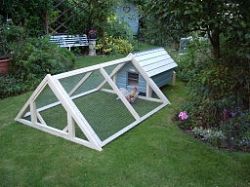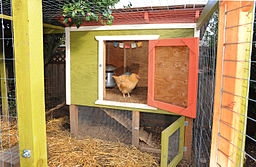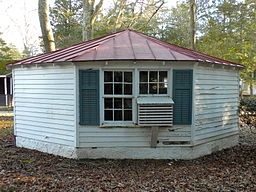The Best Design For A Chicken Coop

Chicken Coop Design For Good Poultry Practices
When you look at some of the hen houses that people put up you might wonder whether there are any chicken coop design requirements at all! Old pallets thrown together, bits of wire hanging off moldy planks, tatty plastic sheeting - it seems as if anything will do for those poor birds. But there is absolutely no reason for not using one of the many chicken coop designs available when planning your poultry pen.
If you want those lovely free-range eggs, or even those tasty free-range chicken drumsticks for your BBQ, then you should be prepared to put in some research to find the best hen house design to fit your requirements.
Let's take a look, then, at what DIY hen house design and planning are all about.
What's The Best Coop Ever?
You probably have firm views on the best kind of coop for your birds. Which of these types appeal most to you?
Don't Like DIY? - Check out some ready-made products for keeping your hens.
Yes, you can save quite a bit of cash by making your own chicken coop or hen run. But not everyone likes or has the confidence to pick up saw or drill and put a hen house together. Here is a good example of a simple coop that you might like to check out if DIY is not your thing.
The Chicken Coop Site
Perhaps you already have a coop design in mind? A beautiful little shed with a shingle roof, painted a lovely bright blue, with a little wire fence around it to keep your darling hens together, like this one? OK, but first you have to do some boring stuff.
The coop site has to be chosen. Where is it going to be? Will it be mobile (sometimes called a small tractor), semi-mobile (a large tractor) or fixed? Whatever the answers to these questions your coop will need to be sited where there is adequate sunlight but not too much sun; adequate shade, for when there is too much sun; and plenty of fresh air without being in a direct wind. If possible place it where you can keep an eye on it, in case Mr Fox is lurking around.
Once you have a clear idea about the site you then need to look into any local rules that might apply to keeping hens in your backyard. These could include health, zoning and noise regulations, particularly in an urban environment. Some places do not allow poultry at all, but most areas will permit hens for non-commercial purposes. Just check with your local town hall. It helps to have an outline plan in hand when approaching these officials, and listen to their advice. Mostly, they aim to help rather than hinder.
Don't forget to keep your neighbors in the loop as well. After all, they will have to put up with any impact your hens might have on them such as noise and, possibly, smells. They might have dogs or other animals that could pose a threat to your chickens too. They could be easier to convince if you were to mention the possibility of free eggs from time to time! There's no harm in a little bribery, is there?


The Size Of The Chicken Coop
Next step, work out the size of coop that you will need. The basic rule of thumb is a minimum of 4 sq ft (square feet) per bird. Thus 4 hens would need a coop with a floor area of roughly 16 sq ft. If you mark this out you will find it quite a small area. Incidentally, 3 hens is considered the minimum number you should have in a flock. Hens are sociable animals and need a few mates to keep them company, otherwise they get depressed and don’t lay eggs.
Life has a habit of catching you out if you work on minimums though. Nearly everyone who starts off with just a few birds ends up adding a few more, then a few more after that. Soon you might have 12 or more hens, so it is a good idea to plan for this at the outset. Making a chicken coop that seems a bit on the large side is definitely a good idea in the long run.
If you are going for the mobile variety you can always start with one small tractor, then add others later.
Keep Your Hens Safe!
Hens are vulnerable to a wide variety of predators, depending on where you live. These will almost certainly include rats and foxes. Dogs and coyotes can be a problem, as can raccoons and the entire weasel family. Don't forget threats from the sky - most places have hawks and other birds of prey too.
Some of these predators tend to operate only at night, others by day and some all the time. You need to research the likely threats in your area and plan safety precautions accordingly. A good place to start is by talking to local poultry farmers and vets.
This means that your coop should probably be raised off the ground, have secure access doors and hatches (raccoons are very clever at undoing door catches) and have a predator-proof wire fence on all sides.
The fence should be made of 1 inch (25 mm) galvanized steel mesh with a wire thickness of between 19 and 22 gauge (about 1 mm) in either a square or hexagonal pattern. It should be buried to a depth of about 12 inches (30 cm), as should the fence posts. That should prevent all the usual burrowing predators from getting access.
Ideally the fence should reach up to the top of the coop sidings, with the coop roof overhanging the fence. If you feel the need to cover the chicken run to keep the aerial threats at bay, you can use old fishing nets to reduce costs.
Where To Get Your Chickens
Here is a surprising way to increase (or start) your flock, indulge your poultry passion or just enjoy the whole chicken experience.
And Finally, The Best Hen House Design
Now comes the fun part - designing your coop! There are all sorts of shapes and sizes, from simple sheds to elaborate buildings. Here are a couple in the photo gallery below to illustrate my point.


Every good hen house will include the following features:
- Weather protection. The hens need to be comfortable and dry. The roof must be weatherproof. Sides are less important, as adequate ventilation is also a must. They need shade provision in hot sun conditions.
- Ventilation. Chickens need fresh air but do not like being in a draft. In warm climates it might be sensible to have at least 2 sides of the coop framed in wire mesh, with solid sides facing the prevailing winds.
- Lighting. In poor natural light conditions consider adding artificial lighting in the coop. The lighter and airier the coop the better.
- Food and Water. Hens need water at all times, so fit at least one waterer in the coop. One for every 4 birds is a better idea, as is the automatic waterer that will ensure water is always available. Chickens will only eat what they need, so there is no problem giving them a feeder in their coop. It can be topped up daily. Avoid giving them food and water in open dishes such as dog water bowls. The hens will jump around in them, upset them and generally make a huge mess!
- Perches. Hens love to perch on things when at rest, so give them a roosting pole to keep them happy. It should be about 5 inches above the floor and provide enough room for each hen without crowding. You can fit more than one perch if necessary.
- Nesting Boxes. Hens like quiet, dark corners to lay their eggs. You need easy access to those eggs. The answer is a nesting box attached to the outside of the coop but with an opening to the inside, a little off the floor but below the roosting perch. It will have a hinged lid so that you can collect the eggs. Fit one for every 4 or 5 laying hens and collect the eggs daily.
- Maintenance Access. The coop should have a good-sized door so that you can get inside easily to clean and change the bedding. Some people place a plastic tray under the roosting pole to catch the droppings easily; others fit a sliding floor so that it can be pulled out entirely for cleaning.
- Exit Ramp. The coop should be raised off the ground, not only for protection from rats and other such predators but also for good ventilation under the floor to prevent rot and keep smells down. The hens therefore need an exit door and ramp to reach their run. See the attached pictures for examples of this arrangement.
- Services. Water and electricity supplies to the coop might make life easier, especially if automatic waterers and feeders are fitted. Also for lights to ease those maintenance tasks in winter.
Chicken Coop Construction
Don't skimp on the materials used to build the coop. It needs to be strong and weatherproof. And able to support humans walking around inside, if it is that big!
Avoid using treated wood, which can be poisonous to animals. If re-using old timber (and why not?) be careful to remove nails and other sharp objects, and sand down rough surfaces.
I really recommend using some good chicken coop plans for the assembly. You can get free ones from the internet but might find these tend to be a bit sketchy. Professionally-produced hen house plans are much better and really don't cost very much.
The great advantage with these is that you will be presented with a wide range of designs and know that each will include all of the design essentials that I have outlined above. The other plus is the materials list. Making your own list of materials that will be needed to finish the coop can be quite difficult and tiresome. It's much better to have it done for you, with all the quantities and cutting dimensions laid out clearly.
Assembly starts at floor level. After placing and sinking the support posts the floor frame will be attached to them, then the floor panels fitted. The side frames will be built up next, the roof frames fitted on top, then the roofing. Sidings or wire meshing will be attached as appropriate, and finally the doors, windows, nesting boxes and all the other bits and pieces.
Fill all seams and joints to prevent unwanted drafts, then finish off with a coat of paint on the outside of the coop, or at least treat it to a weatherproofing stain.
None of this is difficult, and it is definitely worth while making the extra effort to do it all properly. A good coop is not only functional but beautiful too. You could celebrate its completion with a chicken BBQ. Sorry, did I just say that?
So there you have it - this is what makes the best design for a chicken coop!
Chicken Coop Gadgets Anyone?
Here are some essential and some not-so-essential devices that you might want to add to your hen house, to improve the comfort and happiness of your precious birds - and also improve their egg-laying!


And What About Some Good Books?
There is a bewildering variety of chicken books on the market, and no doubt you will end up with many of them on your bookshelf once you get into keeping hens seriously. Here are a couple that I strongly recommend to start your collection.

Here Are Some Useful Poultry Links - For People Who Love Their Hens
There are so many people who love their hens and want to know all there is to know about raising chickens, design of chicken coops, hen health, diets and so much more. These are a few links that I think might be useful.
- The Poultry Club of Great Britain
The place to go for all things chicken (as well as ducks, geese and turkeys). Keeping hens, breeds, standards, egg laying, showing, conservation and many useful links to other poultry sites. Well worth a visit. - Some Neat Ideas For Chicken Coop Designs
More ideas about designing and building your own chicken coop. - Chicken Coop Photo Gallery
More than 150 photos of chicken coops, just to give you some more design ideas.
Like to share your chicken coop experiences, or anything else about raising hens for that matter?







